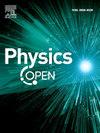Thermal electron-hydrogen laser assisted three-body scattering dynamics
IF 1.4
Q2 Physics and Astronomy
引用次数: 0
Abstract
Laser-assisted scattering (LAS) refers to the interaction of particles, such as electrons and atoms, in the presence of an external laser field. This process is vital in fields like radiation-matter interaction, plasma physics, laser cooling, medical lasers, and nanotechnology, as it aids in understanding and controlling atomic-scale phenomena. This study presents a theoretical model for LAS in both thermal and non-thermal environments using a modified thermal Volkov wave function, thermal potential of the hydrogen atom, and Bessel functions within the first-order Born and Kroll-Watson approximations. The model was implemented in MATLAB and analyzed under varying parameters—scattering angle, distance separation, incident energy, temperature, and Bessel function order. Results indicate that for linear polarization, the differential cross-section (DCS) exhibits constructive and destructive interference patterns. Lower-order Bessel functions yield higher DCS values across all cases. DCS is higher at low (<95°) and high (>270°) angles and lower in the intermediate range. For circular and elliptical polarizations, DCS shows destructive interference with angle variation. Higher temperatures and lower Bessel orders consistently lead to higher DCS, with the effect diminishing at larger separations due to interference. The DCS decreases with increasing incident energy. Overall, thermal environments show significantly higher DCS compared to non-thermal cases. Though purely theoretical, this work suggests potential applications in quantum thermal machines, quantum batteries, and temperature-sensitive quantum systems, particularly where temperature fluctuations are minimal. The absence of experimental validation remains a key limitation.
热电子-氢激光辅助三体散射动力学
激光辅助散射(LAS)是指粒子(如电子和原子)在外部激光场存在下的相互作用。这一过程在辐射物质相互作用、等离子体物理、激光冷却、医用激光和纳米技术等领域至关重要,因为它有助于理解和控制原子尺度的现象。本研究利用改进的热Volkov波函数、氢原子的热势和一阶Born和Kroll-Watson近似中的Bessel函数,提出了热和非热环境下LAS的理论模型。在MATLAB中实现了该模型,并对散射角、距离分离、入射能量、温度和贝塞尔函数阶数等参数进行了分析。结果表明,对于线偏振,微分截面(DCS)表现出相消干涉模式。低阶贝塞尔函数在所有情况下产生更高的DCS值。DCS在低(<95°)和高(>270°)角度较高,在中间范围较低。对于圆偏振和椭圆偏振,DCS表现出随角度变化的相消干涉。较高的温度和较低的贝塞尔阶数始终导致较高的DCS,由于干扰,在较大的分离处效果减弱。DCS随入射能量的增加而减小。总的来说,与非热环境相比,热环境显示出明显更高的DCS。虽然纯粹是理论上的,但这项工作表明了在量子热机、量子电池和温度敏感量子系统中的潜在应用,特别是在温度波动最小的地方。缺乏实验验证仍然是一个关键的限制。
本文章由计算机程序翻译,如有差异,请以英文原文为准。
求助全文
约1分钟内获得全文
求助全文
来源期刊

Physics Open
Physics and Astronomy-Physics and Astronomy (all)
CiteScore
3.20
自引率
0.00%
发文量
19
审稿时长
9 weeks
 求助内容:
求助内容: 应助结果提醒方式:
应助结果提醒方式:


